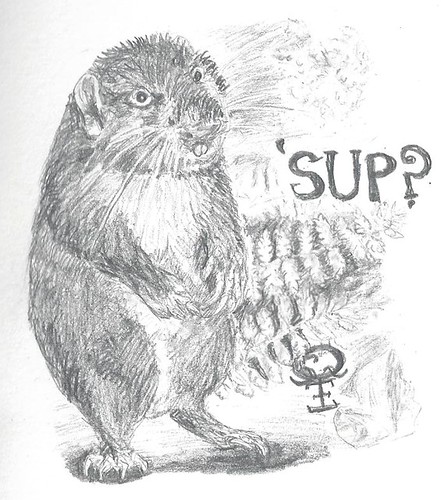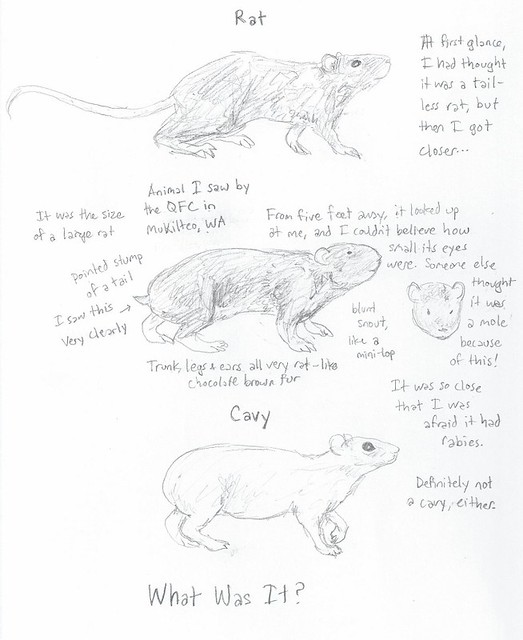` It appeared to be a tailless rat, but something (besides this one girl) told me that it was something else. Perhaps a marmot? My first clue that it was neither would have to be the tail -- clearly hairless, short and pointed, like a hamster's. When it stood up on its hind legs and sniffed at me from only a few feet away, I noticed how bizarrely tiny its eyes were.
Here's my own rendering of what I had seen, only fluffier
(also, it's in a world where leaves hover in the air and lighting schemes don't make sense).
(also, it's in a world where leaves hover in the air and lighting schemes don't make sense).
` Shrews, yes, but rodents are quite distinct from shrews (for one thing, rodents have massive incisors for gnawing on plants, whereas a shrew has a great many pointed teeth for catching insects).
Meanwhile, Lou Ryan teased me from the parking lot whilst I explained to the others that this was probably a little-known native rodent (perhaps related to pocket gophers), and that it was now mandatory that I figure out what it was -- and blog about it!
After getting caught up in TAM, I realize it's been a couple of months, so let's get on that after the page break...
I did my best to memorize what the rodent looked like and drew it the best that I could, adding a rat (for comparative purposes) as well as a wild guinea pig (which also has very little tail), thereby obviating the fact that it could be neither.
Of course, about 40% of all mammal species are rodents, so that barely narrows it down.
To figure this one out, I checked my old mammal encyclopedia and lists of local rodents, but none of the pictures seemed to match my suspect. The mystery began to gnaw at my brain, and for that you can blame my lifelong obsession with the other semi-intelligent agents in the world (the non-human ones, that is -- I've only more recently become interested in the human ones).
The perverse truth is, I'm used to instant gratification when it comes to identifying animals: The hundreds of books and thousands of hours of nature programs that I absorbed throughout the 1990s gave me a pretty good understanding of both classification and anatomy.
` While I could tell a tiger from a lion based on shape alone, this type of "backwards" thinking -- i.e. that two dogs of the same breed look "almost exactly the same, except for the color" -- had earned me some amount of ridicule.
` Thinking myself to be stupid for this way of instantly recognizing species, it hasn't been until recent years that I've begun to appreciate it.
Imagine my astonishment when this ability, which I've now been taking for granted, had failed me! Not sure what to do next, I sent out some emails to various people and, failing to get a correct response, I emailed natural history illustrator Carl Buell, who responded:
Hi Spoony, It sounds and “looks” – nice drawings – like a “mountain beaver” or Aplodontia (Aplodontia rufa). They are found in a rather limited range along the Pacific coast and into the northern Sierra Nevada in California. I’ve only seen a couple myself (near Mt. Lassen) and both times they looked tailless to me, but there’s really nothing else it can be. (Small eyes, small rounded ears, tiny tail) The animal is probably used to being fed or quite young (8 inches is small – they are a little bigger as adults) which is why it approached you, although even the backcountry animals I’ve seen were very tame.Upon checking this for myself, a very loud "D'OH!" involuntarily escaped my lips: As the first rodents listed in my Mammal Encyclopedia, I had known that mountain beavers existed for some time -- and that they were neither mountains nor beavers -- but hadn't made the connection.
` I emailed him back in profuse thanks for solving my mystery before my head had exploded (thus ending my days as a writer). True, many photos of Aplodontia don't quite seem to look like the one in the comparison drawing, but this photo of a deceased specimen at Harvard is dead on. (Har!)
That is, except for the claws: Although the creepy hands of Nicodemus the rat from The Secret of NIMH had briefly flashed through my mind, I otherwise did not make a mental note of how freakishly long the claws looked.
Besides the small eyes, Aplodontia rufa may look rather ordinary, but I later found that it's quite unusual in being the only remaining species of primitive-looking rodents (creatively) called aplodontoids. This group dates back to the mid-to-late Eocene (around 40 million years ago), when its most ancient (and slightly squirrel-like) relatives such as Spurimus and Prosciuris pocked the soil with their burrows.
` It is possible that one of those genera gave rise to Aplodontia's lineage, since according to molecular studies (for example Adkins et al. 2001), its ancestors split from the squirrel lineage about 40 million years ago.
Aplodontia is also the only living rodent that retains a primitive jaw structure from more primordial rodents, although certain aspects of its cheek teeth and various skeletal features are more specialized than those of some modern squirrels.
` Its name comes from the Greek aploos ("simple") and odontos ("tooth"), because the cheek teeth grow continuously and are almost completely round, with a single depression in the center, as well as a projection off the inner edge that is not seen in any other mammal.
Now, if this is the type of information that I'm used to gathering, then how did I miss the Aplodontia on the list of local rodents? Easy -- because I had ruled out many species in advance (mice, beavers, and porcupines being among the most obvious).
` While I did skim over the mountain beaver material, I had always thought that they were about five times the size of a rat, with a tuft of fur on the tail, and so didn't pay much attention to this.
` Besides, if it's called a mountain beaver, then why was it on the coast, literally as far away from the mountains as one could get in Western Washington? Well, it turns out that they are partial to temperate rainforests, whether they be on mountains or not.
This is just one little example of how only a little bit of (inaccurate) knowledge can be a dangerous thing -- especially if one's head is at risk of exploding. Quite honestly, there is something unsettling about looking at such an adorable backyard animal, yet not know what it is.
Ooh, it's gathering plants! Scary!
It's actually nice to feel a bit spooked for once, as this is the first time I've ever come close to understanding why some people report seeing the 'weird animals' or 'monsters' that have made the rounds in the sensationalistic news media.` In fact, I was just watching a "Captured Yeti" video, and these were my exact thoughts: "That kinda looks like a bald raccoon, but its tail is too long and... oh, those are civet legs! That's what that is!" Afterwards, I found an article about this video that confirmed my observation.
` Needless to say, I have real trouble believing that people who regularly hunt (and skin) Chinese animals could ever think it was a bear, much less some sort of mythical creature. Then again, there was that big game hunter who claimed that an arthritic, mite-infested coyote hybrid was instead a powerful and menacing bipedal Chupacabra.
` What's more, she developed a large following since animals like mangy coyotes and mutant "Sampson foxes" look creepy to many people. Oh yeah, and so do hairless sloths, especially when they are described as frightening and aggressive beasts. Really?
To me, hairless or otherwise malformed animals don't look strange to me, so imagine my excitement in 'discovering' one that did! And speaking of hairlessness and discoveries, the story of how our dear little rodent entered into Western culture begins with fur that was without the rest of the animal!
No, really -- in 1806, some Chinook people gave a number of very nice fur robes to American explorer Meriwether Lewis, up at Fort Clatsop. They called the robes shewalal -- although ogwulal was their name for the animal.
` Meriwether didn't know that, though, and so he called the animal a 'sewelel', in what I'd imagine was the very first written passage ever describing these rodents.
This is what happens when you don't speak the same language as your only wildlife experts. D'oh!
Nevertheless, the animal has often been called a 'sewelel' since then. It's also been called 'boomer' or 'whistler' (even though it doesn't seem to make those sounds), or by the Nisqually name, show'tl.
` Settlers probably named it 'mountain beaver' because of its habit of stripping trees of their bark, chewing through small limbs, and devouring helpless baby trees.
` Indeed, they can eat perhaps half of the fir seedlings planted around their burrows, which is why the forestry industry has so many methods of controlling the damage/killing the animals.
Most of all, however, Aplodontia eat lots of ferns and other herbacious plants, which they pile into a 'haystack' to dry outside of their burrow, and then store in a special underground chamber.
` So, if you live in the Pacific Northwest and your rhododendrons and small trees are experiencing mass destruction whilst there are nearby burrow holes where vegetation is heaped (or propped with sticks on top of the holes), you may want to put up some wire fencing and other barriers to protect your trees and bushes.
Part of the reason why this species eats so much is because its digestive system isn't the most efficient, and like many rodents (and rabbits), it actually has to eat its own poop in order to survive. Not that it doesn't first sort out the good poop from the bad -- it stores the fresher pellets in its food storage chamber, whereas the stuff that's gone through its digestive system twice is discarded into a back room.
` Also -- somehow fittingly -- an Aplodontia's kidneys are not the best at concentrating uric acid, so it must consume about a third of its body weight in water each day, which it does mostly by eating succulent plants.
A mountain beaver's normal body temperature is rather low, so during the cold, rainy winter, it spends a lot of time underground keeping itself warm in a bed of plant material. In hot weather, it is not able to pant or sweat, so it sprawls out above-ground where it is vulnerable to predators such as bobcats and coyotes.
` What's more, these animals don't tend to get along with one another, so if a weasel or a mink should invade one's burrow, it's on its own!
How the aplodontoids survived for 40 million years, beats me, especially since today's Aplodontia are the only home of the largest-known species of flea, Hystrichopsylla schefferi, which measures up to eight millimeters in length.
Interesting stuff -- which I would not have learned if it weren't for a very unexpected encounter!
In conclusion, if you have such an unexpected encounter and are having trouble solving it on your own, remember that wildlife experts, biologists, or perhaps even natural history artists will probably have the answer you're looking for.
` If more people did that, they wouldn't make such idiots out of themselves on TV and I think the world would be a better place.



Thanks for this post. We just spotted a mountain beaver in Gig Harbor!
ReplyDeleteWe saw one on the 4th of july in Bremerton Washington. Thank you for posting this! I was going nuts trying to identify it
ReplyDelete